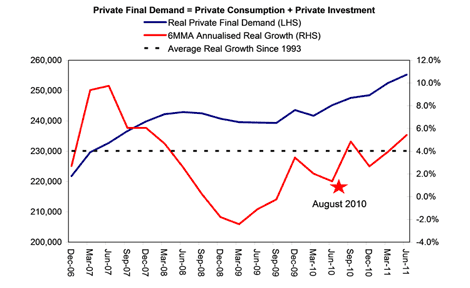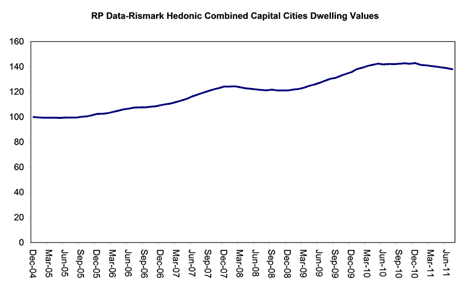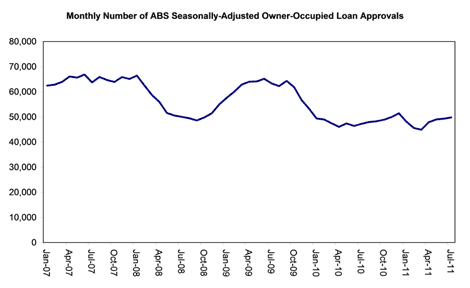The economy and housing market are stronger than you think

As we move on into the spring it is an opportune time to “take stock” and see where the Australian economy, and its housing market, are heading.
Yesterday we received the official economic growth data from the ABS, which while surprising on the high side, confirmed the medium-term outlook I pitched in August last year.
The smart money was punting on relatively uninspiring real growth of 0.9% in the second quarter, which was going to be driven by an inventory rebuild after the floods. Instead, we generated substantially greater 1.2% real GDP growth, which was notable for being surprisingly broad-based. This was even more impressive given the flood-induced contraction in the first quarter was revised down from -1.2% to -0.9%, which meant that the second quarter was starting off a higher base.
The details surrounding
A reader referred me to a statement I had made in August 2010. Specifically, I argued, “the economy is about to embark on a period of above-trend growth.” Naturally, I am no weather forecaster. So I will admit that I did not predict the savage
Yet even in the face of these unanticipated events (and some extraordinary geopolitical turbulence in the Middle East and Europe), yesterday’s statistics tell us that real private final demand in Australia – that is, private consumption plus private investment – has been advancing at a well-above trend 5.4% annualised pace over the first six months of 2011 (see chart). There is no doubt that had
Here HBSC’s chief economist, Paul Bloxham, comments: “Domestic demand is rock solid. That’s the key message from [yesterday’s] GDP release. Yes, the
Notwithstanding the many hysterical claims that both consumer spending and the non-mining economy are weak or in recession, including from some of the RBA’s conflicted independent board members, the non-mining sector managed to expand by 1.2% in the June quarter. Even the reportedly death-spiral-bound manufacturing sector grew by a vigorous 2.8% over this period.
It also turns out that Australian consumers are spending money at very normal rates. Consumption increased by a strong 1% (real) in the June quarter, and has risen by a trend-like 3.2% over the last 12 months, which is its best rate in a year and accounted for almost half of all GDP growth. Importantly, there has been a shift in consumer spending away from goods towards services, which surged 2% in the quarter and are growing at an annual rate of 5.5% (the highest since 2008).
On this note, RBS’s highly regarded chief economist Kieran Davies argues: “This supports our view that the monthly retail sales numbers – which continue to exert a strong influence on financial markets – are no longer a good guide to overall consumer spending. It also makes us wonder about the link between consumer [confidence surveys] and spending, which our past research has shown is not a consistent predictor of consumption.”
In concert with healthy consumer activity, we saw the household savings rate fall from a recent high of 11.7% to 10.5% while real, net per capita disposable income increased by 2.9% over the June quarter to hit its highest level ever ($48,988 for every man, woman and child in Australia).
In summarising the GDP numbers, UBS chief economist Scott Haslem opined: “Today's data reveals much more underlying strength in the economy in the second quarter than anticipated, with the likely temporary weakness in exports and the unwinding of public capex from the GFC stimulus masking a 'private economy' expanding above trend.”
So where does that leave
The 2011 outcomes are broadly in line with what we forecast in October 2010. At the time, I commented, “Our analysis suggests that a substantial increase in rates would put some downward pressure on dwelling prices…. It is now just a matter of time before the RBA and/or the banks raise rates again.” As it happened, we got a sharply felt double hike a month later in November.
The additional dynamic in 2011 has been the remarkable conviction of households that they will be hit by more rate hikes. As recently as August this year, Westpac’s survey analysis suggested that Australians were budgeting on another two rate hikes with an amazing 29% of respondents expecting more than four hikes. In a sense, therefore, the housing market has been behaving as if it is being constrained by interest rates that are actually higher than current levels. In central banker speak, this is the benefit of “jaw-boning” on rates: that is, compelling behavioural changes without actually having to touch the interest rate lever.
Set against these challenging conditions are some reasons for optimism.
First, the RBA has, in practice, ignored the very high core inflation numbers that were published by the ABS in the first and second quarters of 2011. That is to say, consumers’ hawkish interest rate expectations have not been satisfied.
Second, economists believe that there will be no hikes this year. Indeed, Goldman Sachs and Deutsche Bank are both bravely predicting interest rate cuts (!) in October and November, according to Bloomberg data. AMP and Westpac forecast one cut before the year is out. And Macquarie Bank and Westpac are predicting that rates will be a full percentage point lower (i.e., the equivalent of four cuts) by the end of next year.
If these projections prove accurate, we are likely to see a rebound in housing activity. I should add for the record that I do not personally agree with them. I believe the next move in rates will still be up, not down, and do not think the RBA will be relaxing policy until some time in the second half of 2012.
But let’s hope I am wrong: in particular, let’s cross our fingers that the third-quarter inflation numbers prove benign, and the RBA does not as a consequence feel the need to tighten the screws again. Nobody wants an inflation problem in this country: inflation is, after all, a tax on prudent net savers, and inevitably means higher rates for those of us with loans.
A third positive portent is to be found in the housing finance data. In August
As a final observation, we are seeing some de facto cuts in the fixed-rate home loan market caused by the inversion of the yield curve. It is now possible to get three-year fixed-rate loans for around 6.4%, which is substantially below the headline standard variable rate of over 7.5%. This is based on a more bearish economic outlook, which is being driven by both the offshore turbulence and conflicting domestic data, such as today’s unemployment survey. Only 600 net new jobs have been created in the last 3 months, which has forced the unemployment rate up to 5.3%. This will help the RBA do its inflation-fighting job and, at the margin, reduces the probability of future rate hikes.
Christopher Joye is a leading financial economist and works with Rismark International. Rismark and RP Data provide house price analytics products, and solutions that enable investors to go long and/or short the housing market. The above article is not investment advice.


